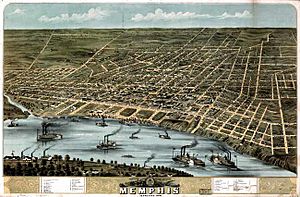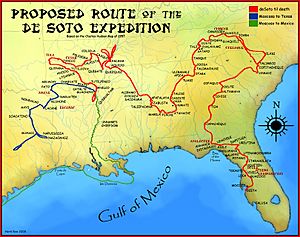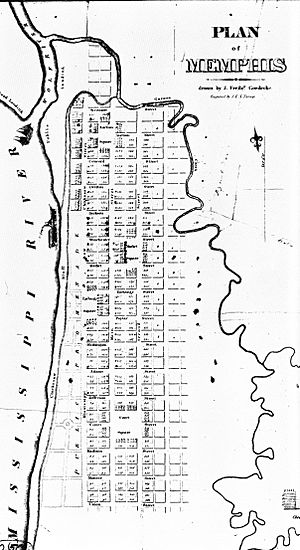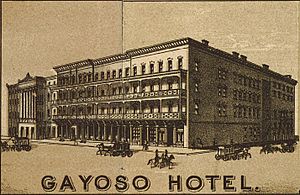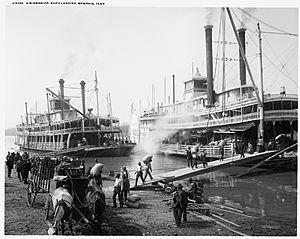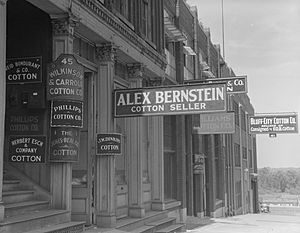History of Memphis, Tennessee facts for kids
The story of Memphis, Tennessee began thousands of years ago with different groups of native people. Around 800 CE, the Mississippian culture lived here. Later, the Chickasaw tribe either developed in the area or moved there by the 1600s. Early European explorers like Hernando de Soto from Spain and French explorers led by René-Robert Cavelier, Sieur de La Salle likely met these native groups.
The modern city of Memphis was officially started in 1819. It was named after the ancient capital of Egypt on the Nile River in North Africa. Memphis quickly grew into a major trading hub for cotton. This cotton was grown on large farms and relied on the hard work of enslaved African Americans. In the late 1800s, especially in 1878 and 1879, the city faced terrible yellow fever outbreaks. Thousands of people fled, and over 5,000 died in 1878 alone. This caused the city to go bankrupt and lose its official city status until 1893.
In the early 1900s, cotton was still very important. Memphis became the world's biggest market for cotton and hardwood lumber. During the 1960s, the city was a key place for the civil rights movement. A big strike by city sanitation workers happened in 1968. Rev. Martin Luther King Jr. came to Memphis to support these workers. Sadly, he was assassinated by a sniper on April 4, 1968, at the Lorraine Motel.
Many famous blues musicians grew up in and around Memphis and northern Mississippi. These included musical legends like Muddy Waters, Robert Johnson, B.B. King, Howlin' Wolf, Isaac Hayes, and Elvis Presley.
Contents
Early History of Memphis
About 10,000 years ago, early people called Paleo-Indians and later Archaic-Indians lived as hunter-gatherers in the area that is now the southern United States. From about 800 CE to 1600 CE, the Mississippi River Delta was home to tribes of the Mississippian culture. These were mound-building Native American people. The Tipton Phase people were a local group of the Mississippian culture. They lived in the region when the first Europeans, led by de Soto, arrived.
By the end of the Mississippian period, the Chickasaw tribe lived in and claimed this land. The Chickasaw's exact origins are not fully known. Some historians think they might have come from present-day Mexico and moved north. When Europeans first met them, the Chickasaw lived in villages in what is now Mississippi. Their own stories say they moved from west of the Mississippi River a long time ago.
European Explorers Arrive
Spanish explorer Hernando de Soto is thought to have visited the Memphis area as early as the 1540s.
In the 1680s, French explorers led by René-Robert Cavelier, Sieur de La Salle built Fort Prudhomme nearby. This was the first European settlement in what would become Memphis. Later, Jean-Baptiste Le Moyne de Bienville's French army built Fort Assumption in 1739. This fort was on the fourth Chickasaw Bluff on the Mississippi River. It was used as a base during a short war against the Chickasaw.
Even with these early outposts, the land that is now Memphis remained mostly unsettled by Europeans for most of the 1700s. The borders of what would become Tennessee changed over time. In 1796, this spot became the westernmost part of the new state of Tennessee. However, the Chickasaw tribe still lived in and controlled West Tennessee at that time.
Memphis in the 1800s
City is Founded in 1819
The land in West Tennessee became open for white settlement after the U.S. government bought it from the Chickasaw Nation in 1818. Memphis was founded on May 22, 1819, by a group of investors. These included John Overton, James Winchester, and Andrew Jackson. The city officially became a city in 1826. It was named after the ancient capital of Egypt on the Nile River.
The founders planned for a large city. They laid out a grid of streets with four town squares: Exchange, Market, Court, and Auction. Today, Market, Court, and Auction squares are still public parks. The city grew in the 1800s as a center for moving and selling the large amounts of cotton grown in the nearby Mississippi Delta.
Memphis was a starting point on the Mississippi River for Native Americans forced to leave their homes in the 1830s. This sad journey was called the Trail of Tears. In 1831, a French writer saw many Choctaw people crossing the river at Memphis.
The cotton farms in the South before the Civil War relied on the forced labor of hundreds of thousands of African-American slaves. Memphis became a major market where enslaved people were bought and sold. Before the Civil War, one-fourth of the city's population were slaves. Many enslaved people tried to escape to freedom in the North using the Underground Railroad. The home of Jacob Burkle in Memphis was a safe stop on their journey.
The Gayoso House Hotel was built overlooking the Mississippi River in 1842. It became a famous Memphis landmark. In 1857, the Memphis & Charleston Railroad was finished. This railroad connected a port on the Atlantic Ocean with one on the Mississippi River. Memphis was also a stop on the Butterfield Overland Mail route to California from 1857 to 1861.
Civil War in Memphis
During the American Civil War, Memphis was an important city. It had strong river trade and railroad links, especially the Memphis and Charleston Railroad. This was the only east-west rail line across the South. Tennessee left the Union in June 1861, and Memphis briefly became a Confederate stronghold.
Union forces captured Memphis from the Confederacy in the Battle of Memphis on June 6, 1862. The city stayed under Union control for the rest of the war. The Gayoso House Hotel was used as a Union headquarters.
Memphis became a Union supply base and continued to do well during the war. The city became a place for illegal trade in raw cotton. Northern cotton mills greatly needed cotton because of the Union blockade and the Confederate embargo.
Thousands of enslaved people escaped from farms to Union lines. The Army set up a camp for them south of the city. By 1865, there were 20,000 Black people in the city, a huge increase from 3,000 before the war. The presence of Black Union soldiers caused tension with white residents, especially the many Irish immigrants. In 1866, a major riot happened where whites attacked Black people. Forty-five Black people were killed, and much of their housing was destroyed. By 1870, the Black population was 15,000 out of a total city population of 40,226.
Yellow Fever Epidemics
Severe yellow fever epidemics hit Memphis in the 1870s (1873, 1878, and 1879). In 1873, about 2,000 people died. When yellow fever was found in August 1878, over 25,000 people left the city in just two weeks. Many moved to other cities like St. Louis. People were so scared that they left their homes with doors open and valuables inside. Before the epidemic, the population was about 50,000. Of the 19,000 who stayed, 17,000 got yellow fever, and 5,150 died.
At that time, people did not know that mosquitoes carried the disease. So, public health efforts were not successful. Many Catholic and Episcopalian nuns and priests stayed to care for the sick and sacrificed their lives. Another epidemic broke out in 1879, killing several hundred more. So many people died or left that in 1879, Memphis went bankrupt and lost its city charter. Until 1893, the state governed Memphis as a "Taxing District."
Robert R. Church, Sr., a freedman, became known as the South's first African-American millionaire. He was the first citizen to buy a $1,000 bond to help pay off the city's debt and restore its charter. He bought a lot of real estate when the city's population dropped after the epidemics. He started the city's first Black-owned bank, Solvent Savings Bank. This bank helped Black people get loans for businesses and homes. Because the city's population had fallen, Black people found new opportunities. They were hired as police officers until 1895, when segregation forced them out.
The city improved its sanitation, building a new sewer system. This helped remove mosquito breeding grounds. In 1887, a source of clean artesian water was found under the city. This helped Memphis recover.
In 1892, the first Mississippi River bridge at Memphis opened. The city began to do well again and got its city charter back in 1893. However, African Americans faced many challenges. Their schools were underfunded due to segregation. State laws passed in the late 1880s took away their right to vote and participate in politics. A system of Jim Crow based on white supremacy was put in place. By the late 1890s, Black people were no longer allowed on the police force.
Memphis in the 1900s
Business Growth
Memphis grew to become the world's largest market for cotton and hardwood lumber. Both were important products from the Mississippi Delta. Until the 1950s, it was also the world's largest market for mules. From 1900 to 1950, the city's population almost quadrupled, from 102,350 to 396,000 residents.
Memphis built many parks and public works as part of the national City Beautiful Movement.
The Memphis Parkway System (including Overton Park) was designed by landscape architect George Kessler in the early 1900s.
Clarence Saunders, a Memphis inventor, opened a self-service grocery store in 1916. He founded the first supermarket chain, Piggly Wiggly. Saunders became very rich but lost his money later. He had to sell his partly built mansion, called the Pink Palace. The Pink Palace became the city's history and natural history museum.
The famous Peabody Hotel opened in 1923. It became a symbol of Southern elegance. In 1935, author David Cohn wrote that the Peabody was like the "Paris Ritz" for the Mississippi Delta region.
City Politics
From the 1910s to the 1950s, Memphis was controlled by a political machine led by E. H. "Boss" Crump. He was a Democrat. Crump used common tactics of a big city boss, like controlling elections and giving jobs to his friends. He worked with powerful people at local, state, and national levels. He made sure that people who disagreed with him had little say.
Crump was a strong supporter of Franklin Roosevelt and the New Deal. Because of this, Memphis received many government programs. These programs provided jobs for people who were unemployed. The city also got major federal building projects, which helped local businesses. Crump included Black leaders in his network, giving them some benefits in return for Black votes. Memphis was one of the largest Southern cities where Black people could vote, but segregation was still very strict.
The city installed a new sewer system and improved sanitation to prevent more epidemics. Clean water from an artesian well was found in the 1880s, securing the city's water supply.
World War II and Beyond
During World War II, the U.S. War Department built large supply depots in Memphis for the Army and the Army Air Force. The Memphis Army Depot also held 800 Axis prisoners of war.
In 1942, the U.S. Navy built the Millington Naval Air Station (now Naval Support Activity Mid-South) just north of Memphis. This large facility trained pilots during World War II. Today, it is a naval personnel center.
The first national motel chain, Holiday Inn, was founded in Memphis by Kemmons Wilson in 1952. His first inn was near the city limit on Summer Avenue, which was the main highway to Nashville, Tennessee.
Population Changes
In 1970, Memphis' population was 60.8% white and 38.9% Black. Wealthier residents started moving to newer homes outside the city. After riots and a court order in 1973 to desegregate public schools, about 40,000 white students left the public school system in four years. Today, the city has a majority-Black population.
Memphis is famous for its cultural impact on the American South. Many well-known musicians grew up in and around Memphis. They moved to other cities, bringing their music with them. These included Elvis Presley, Jerry Lee Lewis, Muddy Waters, Johnny Cash, Robert Johnson, B.B. King, Howlin' Wolf, Isaac Hayes, Al Green, and Justin Timberlake. Aretha Franklin was born in Memphis.
City Expansion
In the 1950s, Memphis was a smaller city. Its southern boundary was near Nonconnah Creek. The northern boundary was close to the Wolf River. The eastern boundary was near Highland Street.
By the mid-1950s, Memphis stretched south to the Mississippi State Line. It also annexed communities like White Station to the east. The northern boundary of Memphis became the Wolf River.
By the mid-1960s, Memphis had annexed Frayser north of the Wolf River. It also annexed Berclair and all of White Station on its eastern border. The city now borders Germantown, Tennessee to the east.
Civil Rights Movement
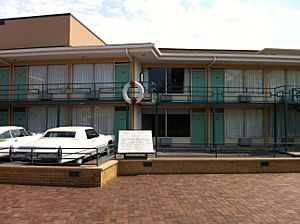
During the 1960s, Memphis was a key place for the Civil Rights Movement. Its large African-American population had faced segregation and had their voting rights taken away in the early 1900s. Black residents used the civil rights movement to improve their lives. In 1968, the Memphis sanitation strike began. Workers, mostly African American, wanted fair wages and better working conditions. They marched to raise awareness about their dangerous work and low pay.
Rev. Martin Luther King Jr., a leader in the non-violent movement, came to support the workers. He stayed at the Lorraine Motel in the city. Sadly, he was assassinated there by a sniper on April 4, 1968. This happened the day after he gave his famous "I've Been to the Mountaintop" speech.
After King's murder, some people in the city rioted. They looted and destroyed businesses. The governor sent National Guardsmen into the city. Fearing the violence, more middle-class families began to leave the city for the suburbs.
Recent History
The entertainer and helper Danny Thomas helped open St. Jude Children's Research Hospital in downtown Memphis in 1962. St. Jude treats serious diseases in children, like leukemia and other cancers. It is known for its high success rates and free treatment for patients. This makes it one of the most respected children's hospitals in the world.
FedEx Corporation started in Little Rock, Arkansas, in 1971. But it moved its main operations to Memphis in 1973. This was to use Memphis' larger airport facilities. As Memphis became the main hub for FedEx, the Memphis International Airport grew into the world's largest airfreight terminal.
In 1974, Harold Ford Sr. of Memphis was elected to Congress. He was the first Black national official elected from Tennessee. He was re-elected many times. In 1994, Memphis elected its first African-American mayor, Dr. W. W. Herenton.
Cultural History
Memphis is well known for its cultural impact on the American South.
The Appeal newspaper, which is now the Commercial Appeal, started in 1841. It supported the Confederacy and moved often during the Civil War to avoid capture. The Commercial Appeal won a Pulitzer Prize in 1923. This was for its reporting on and opposition to the Ku Klux Klan.
Riverboats
From the first steamboats to today, Memphis has been a major center for river travel. Passenger steamers connected Memphis with other river ports until the 1920s. Tom Lee Park on the Memphis riverfront is named after an African-American river worker. Tom Lee could not swim. But he saved thirty-two people from drowning when the steamer M.E. Norman sank in 1925. Today, Memphis Riverboats offer tourist trips on paddlewheel steamers.
African-American Music
Starting in the early 1900s, Memphis became famous for its new styles of African-American music. These included gospel, blues, jazz, soul, and Rhythm and Blues. This tradition continues today. Many famous blues musicians grew up in and around Memphis and northern Mississippi. They performed there regularly. These included Muddy Waters, Robert Johnson, B.B. King, and Howlin' Wolf.
Stax Records, which opened in Memphis in 1957, mostly produced African-American music. Stax was very important in creating the Southern soul and Memphis soul music styles. It also released gospel, funk, jazz, and blues recordings. Stax artists included Rufus Thomas, Carla Thomas, Sam and Dave, Otis Redding, William Bell, and Booker T. & the MG's.
Rock and Roll
In 1950, Sam Phillips opened the "Memphis Recording Service." Here, he recorded for his Sun Records label. B.B. King, Howlin' Wolf, Elvis Presley, Johnny Cash, Jerry Lee Lewis, Carl Perkins, and Roy Orbison all recorded there early in their careers. The young Elvis Presley often listened to gospel and soul music. Many of his early songs were inspired by or written by African-American artists in the Memphis area.
Firsts in Radio
The first radio station with an African American format, WDIA, was founded in Memphis in 1947. A young B. B. King worked there as a disc jockey. B. B. King's nickname came from his WDIA name, "Beale Street Blues Boy." This referred to Memphis' Beale Street, which had many nightclubs and blues venues. WHER, the first all-female radio station, was founded in 1955 by Sam Phillips and Holiday Inn founder Kemmons Wilson.
Food History
Memphis is also known for its long food history, especially its regional barbecue. Memphis barbecue is special because it mainly uses pork. It focuses on ribs and shoulder cuts of meat. There are many local barbecue restaurants. This local food tradition is celebrated every May at the Memphis in May Festival. It holds the annual World-Championship Barbecue Cooking Contest.
Important Districts
Downtown Memphis is the oldest part of the city. It is built on a bluff overlooking the Mississippi River. Downtown includes the old business and government areas. Beale Street and the Lorraine Motel (now the National Civil Rights Museum, where Martin Luther King, Jr. was assassinated) are in Downtown.
The Pinch District is an area that was important for immigrants starting in the early 1800s. It was Memphis' first business district. The name "Pinch" originally referred to poor Irish immigrants. Later, Italian, Russian, Greek, and Jewish immigrants also lived there before moving to richer parts of the city.
Victorian Village has many large Victorian-era mansions. These were built just east of Downtown Memphis when it was the edge of the city. Some of these homes are open for public tours.
Orange Mound was the first African-American neighborhood in the United States built by and for African Americans. It started in the 1890s on a former plantation. It offered affordable land and homes for less wealthy Black people. It was a safe place for Black people moving to the city from the rural South. Residents of Orange Mound often owned their homes and had a strong sense of community.
Midtown, Memphis is a very diverse area in the center of the city. Its buildings are mostly from the first half of the 1900s. Midtown is Memphis' most diverse area in terms of people and cultures. Many schools and cultural places are in Midtown. These include the University of Tennessee Health Science Center, Rhodes College, the Memphis Brooks Museum of Art, the Memphis Zoo, and the Memphis College of Art. Evergreen Historic District, one of Memphis' oldest neighborhoods, is in Midtown.
Education
The first schools in Memphis were started in 1826. But until 1848, all Memphis schools were private. The Memphis City Schools system was formed in the early 1830s. The first "free" public schools opened in 1848. By 1852, taxpayers supported 13 public schools.
The first city school for Black students opened in 1868 during Reconstruction. For a century, the city kept separate, segregated schools for different races. Memphis City Schools began desegregation in the late 1950s, but it was slow. A federal court order in 1973 required the city to use busing to fully integrate the schools. This order was very unpopular with white families. Within four years, 40,000 white students left the public school system. Many white families moved out of the city or enrolled their children in private schools. Some of these private schools were started at this time as "segregation academies."
The University of Tennessee College of Dentistry was founded in 1878. It is the oldest dental college in the South. The University of Tennessee College of Medicine in Memphis was created in 1911.
The University of Memphis first opened in 1912. Christian Brothers University was founded in 1871. Rhodes College moved to Memphis in 1925. LeMoyne-Owen College, a private college for Black students, started as an elementary school for freed slaves in 1862.
Images for kids


